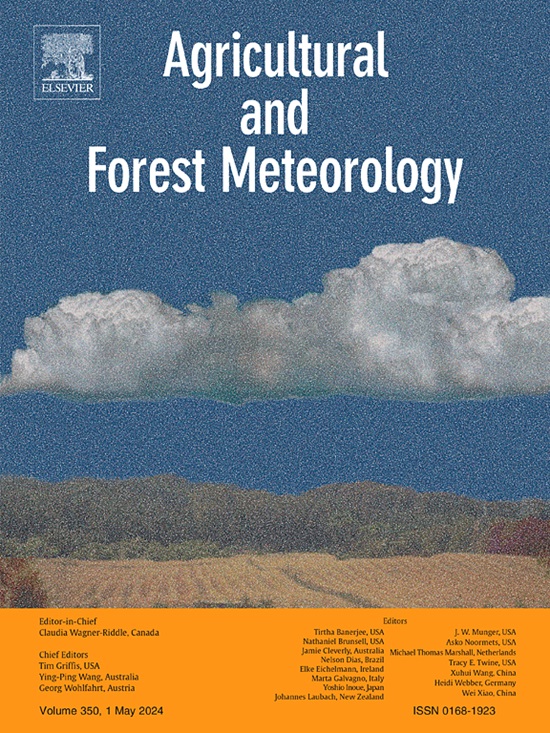维吉尼亚栎林饱和附生植物群落的蒸发和凝结动力学(美国乔治亚沿海)
IF 5.7
1区 农林科学
Q1 AGRONOMY
引用次数: 0
摘要
降雨与森林的相互作用通过改变地表的雨水供应,对水文、生态和社会系统产生重大影响。冠层表面雨水的滞留、蒸发和再分配影响所有与风暴有关的水文过程。生活在森林树冠上的树木附生植物可以储存和蒸发大量的水,但与树皮和树叶相比,它们在降雨分配中的作用尚未得到充分研究。美国东南部的海洋森林有丰富的附生植物群落,主要以复活蕨(Pleopeltis polypodiodes)、凤梨藓(Tillandsia usneoides)和foliose地衣为主。我们评估了在Skidaway岛(Savannah, GA, USA)的海洋森林中,主要寄主树种维吉尼亚栎(南方活橡树)现有附生植被的饱和时间、雨饱和条件下的蒸发和冷凝输入。在为期3个月的研究中,附生菌群饱和的中位数为35%。湿冠层蒸发量在0.06 ~ 0.42 mm h−1之间,而湿冠层凝结量略低,在0.01 ~ 0.15 mm h−1之间。高总蒸发量可能取决于附生植被长时间保持饱和的能力。研究结果为深入开展附生植物群落生态水文研究提供了依据。本文章由计算机程序翻译,如有差异,请以英文原文为准。
Evaporation and condensation dynamics within saturated epiphyte communities in a Quercus virginiana forest (coastal Georgia, USA)
Rainfall-forest interactions significantly impacts hydrological, ecological, and societal systems by altering rainwater supply to the surface. Canopy surfaces’ retention, evaporation, and redistribution of rain affect all storm-related hydrological processes. Arboreal epiphytes, plants that live on forest canopies, can store and evaporate substantial amounts of water, but their role in rainfall partitioning is under-researched compared to bark and leaves. Maritime forests of the southeastern U.S. have abundant epiphyte comunities, largely dominated by the resurrection fern (Pleopeltis polypodiodes), the bromeliad Spanish moss (Tillandsia usneoides), and foliose lichens. We assessed saturation time, evaporation during rain-saturated conditions, and condensation input within existing epiphyte vegetation on Quercus virginiana (southern live oak), a dominant host tree species, in the maritime forests on Skidaway Island (Savannah, GA, USA). Epiphyte assemblages were saturated for a median 35 % of the 3-month study. Wet canopy evaporation ranged from 0.06 to 0.42 mm h−1, while wet canopy condensation was slightly lower, ranging from 0.01 to 0.15 mm h−1. High total evaporation is likely dependent on the ability of epiphyte vegetation to remain saturated for long periods of time. Results from this study provide a basis for detailed ecohydrological research in epiphyte communities.
求助全文
通过发布文献求助,成功后即可免费获取论文全文。
去求助
来源期刊
CiteScore
10.30
自引率
9.70%
发文量
415
审稿时长
69 days
期刊介绍:
Agricultural and Forest Meteorology is an international journal for the publication of original articles and reviews on the inter-relationship between meteorology, agriculture, forestry, and natural ecosystems. Emphasis is on basic and applied scientific research relevant to practical problems in the field of plant and soil sciences, ecology and biogeochemistry as affected by weather as well as climate variability and change. Theoretical models should be tested against experimental data. Articles must appeal to an international audience. Special issues devoted to single topics are also published.
Typical topics include canopy micrometeorology (e.g. canopy radiation transfer, turbulence near the ground, evapotranspiration, energy balance, fluxes of trace gases), micrometeorological instrumentation (e.g., sensors for trace gases, flux measurement instruments, radiation measurement techniques), aerobiology (e.g. the dispersion of pollen, spores, insects and pesticides), biometeorology (e.g. the effect of weather and climate on plant distribution, crop yield, water-use efficiency, and plant phenology), forest-fire/weather interactions, and feedbacks from vegetation to weather and the climate system.

 求助内容:
求助内容: 应助结果提醒方式:
应助结果提醒方式:


